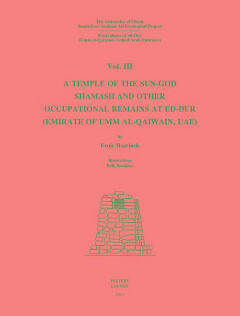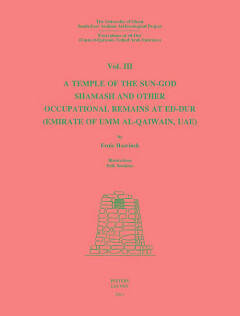
- Afhalen na 1 uur in een winkel met voorraad
- Gratis thuislevering in België vanaf € 30
- Ruim aanbod met 7 miljoen producten
- Afhalen na 1 uur in een winkel met voorraad
- Gratis thuislevering in België vanaf € 30
- Ruim aanbod met 7 miljoen producten
Zoeken
The University of Ghent South-East Arabian Archaeological Project
Excavations at Ed-Dur (Umm Al-Qaiwain, United Arab Emirates): 'Vol. III: A Temple of the Sun-God Shamash and Other Occupational Remains at Ed-Dur (Emirate of Umm Al-Qaiwain, Uae)'
E Haerinck
Paperback | Engels
€ 80,00
+ 160 punten
Omschrijving
Located on the coast of the Emirate of Umm al-Qaiwain (UAE), the site of ed-Dur is without doubt the largest coastal settlement of the late 1st. c. B.C.-1st. c. A.D. between Qatar and the promontory of Musandam. Excavations at ed-Dur by a team from Ghent University (Belgium) resulted in the discovery of the only known temple in SE-Arabia for this period. This temple is a prime source and contributes to a better understanding of pre-Islamic rituals and concepts in the region. The small single-roomed almost square structure was preserved to a height of more than 2 meters, with outside walls decorated with fine plasterwork of marginally drafted ashlar masonry. In the immediate vicinity of the sanctuary a well and several freestanding structures related to the cult were excavated as well as a rectangular stone basin on top of a stone socle. An Aramaic inscription on the basin mentions the name of Shamash, indicating that the temple was built for the sun-god. Furthermore, some altars, offering tables (?) and numerous traces of large fires provide glimpses on pre-Islamic religious beliefs in SE-Arabia. Inside the temple were found some Roman bronzes and a small statue of an eagle made of local limestone. The publication presents the full excavation report as well as an analysis and interpretation of possible rituals that took place in and around the temple. These rituals are equally reviewed against the very limited information we have on pre-Islamic religion and practices in this region (e.g. the Ka'ba at Mecca). Besides the numerous tombs (presented in a previous book: Haerinck 2001: Excavations at ed-Dur, Vol. II. The Tombs), more remains such as domestic architecture, platforms, wells and other occupational remains were also excavated all across the site.
Specificaties
Betrokkenen
- Auteur(s):
- Uitgeverij:
Inhoud
- Aantal bladzijden:
- 34
- Taal:
- Engels
Eigenschappen
- Productcode (EAN):
- 9789042923980
- Verschijningsdatum:
- 26/04/2011
- Uitvoering:
- Paperback
- Formaat:
- Trade paperback (VS)
- Afmetingen:
- 231 mm x 307 mm
- Gewicht:
- 816 g

Alleen bij Standaard Boekhandel
+ 160 punten op je klantenkaart van Standaard Boekhandel
Beoordelingen
We publiceren alleen reviews die voldoen aan de voorwaarden voor reviews. Bekijk onze voorwaarden voor reviews.











